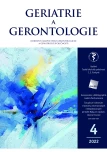Opioid analgesics in the pain management of geriatric patients
Authors:
Skladaná Anna
Authors‘ workplace:
Nemocnice Milosrdných sester sv. Vincence de Paul, Kroměříž
Published in:
Geriatrie a Gerontologie 2022, 11, č. 4: 176-181
Category:
Review Article
Overview
Opioids are an irreplaceable group of analgesics that are recommended for the treatment of moderate and severe pain according to the World Health Organization (WHO) analgesic ranking. Compared to other drug groups, they have significantly lower organ toxicity, especially when compared to non-steroidal antiphlogistic drugs, yet some typical adverse effects (AEs) must be considered. It is these that are often behind the concerns of some physicians and patients, and as a result, pain is not treated effectively enough in a significant proportion of patients. In geriatric patients, there are changes due to the aging of the body that lead to changes in the pharmacodynamics and pharmacokinetics of drugs. The basic lesson for treating elderly patients „start low, go slow“ is doubly true for opioids. With slow titration to the lowest effective dose, a large proportion of AEs can be avoided. Tolerance to some of them develops (nausea, confusion, fading), others persist throughout treatment (constipation). Patients should be made aware of the risk of these AEs, actively sought out and treated effectively. This is the only way to ensure patient confidence and cooperation to continue sufficiently effective analgesic therapy.
Keywords:
side effects – opioids – elderly patients – Analgesics – pain management
Sources
1. Hakl, M. Léčba bolesti: současné přístupy k léčbě bolesti a bolestivých syndromů. Praha: Maxdorf 2022.
2. Rokyta R, Fricová J, Kozák J, et al. Léčba bolesti ve stáří. Praha: Mladá fronta 2015.
3. Bielaková K, Matějovská H, Weber P. Léčba bolesti u geriatrických pacientů – známe její úskalí? Geri a gero 2012; 1 (2): 91–94.
4. Lejčko J. Přehled opioidních analgetik. Praktické lékárenství 2009; 5 (4): 172–175.
5. Vondráčková D. Léčení nenádorové bolesti geriatrických pacientů opioidy. Česká geriatrická revue 2008; 6 (2): 103–108.
6. SÚKL. SPC – Souhrn údajů o přípravku.
7. Lejčko J. Opioidy a nové trendy v léčbě bolesti. Časopis lékařů českých 2018; 157(2): 67-73.
8. Gregorová J. Použití opioidů u seniorů v léčbě chronické bolesti. Edukafarm FarmiNews 2011; 3 : 20–21.
9. Lejčko J. Silné opioidy v léčbě chronické bolesti. Neurologie pro praxi 2006; 3 : 141–144.
10. Kozák J, Lejčko J, Vrba I. Opioidy. Praha: Maxdorf 2021.
11. Rokyta R. Bolest a jak s ní zacházet: učebnice pro nelékařské zdravotnické obory. Praha: Grada 2009.
Labels
Geriatrics General practitioner for adults Orthopaedic prostheticsArticle was published in
Geriatrics and Gerontology

2022 Issue 4
- Metamizole vs. Tramadol in Postoperative Analgesia
- Memantine in Dementia Therapy – Current Findings and Possible Future Applications
- Metamizole at a Glance and in Practice – Effective Non-Opioid Analgesic for All Ages
- Metamizole in perioperative treatment in children under 14 years – results of a questionnaire survey from practice
- Memantine Eases Daily Life for Patients and Caregivers
Most read in this issue
- A Pilot Study of the Mini-Cog Czech version in Czech Adults
- Opioid analgesics in the pain management of geriatric patients
- Vybrané faktory prevence u seniorů
- Obesity and diabetes – trajectories of occurrence in acutely hospitalized seniors and the dynamics of their changes over 27 years
